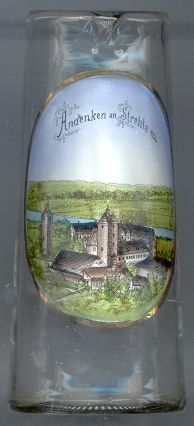

|
| DEUTSCHLAND | GERMANY |
| Bundesland: Freistaat Sachsen | Saxony |
| Landkreis: Riesa-Großenhain |
 Strehla is situated at an elevation of 95 m on the river Elbe in northern Saxony.
The earliest traces of a settlement at this place go back to about 400 BC.
The founders of Strehla are believed to be Slavic settlers since the name Strehla is
likely derived from the Slavic word Strzelna, which means 'arrow'. An arrow is
also part of the ancient coat of arms of the town. The Slavs were gradually replaced
by German settlers in the 9th century and in 1002 the place was first mentioned in a
document. Strehla was situated an a strategically important location: it was the place
where one of the most important European East-West trading routes crossed the river Elbe.
In 1065 Strehla was mentioned as a free Imperial city and at the end of the 11th
century even had the right to mint coins. In 1228 castle and town came in possession
of the bishops of Naumburg. In 1384 King Wenceslav (Václáv, Wenzel) IV of Bohemia (also German King)
donated the castle and dominion to the Pflugk noble family. The town itself
remained their property until 1856, and the castle remained in possession of the family until 1945.
From the 14th century until the early 20th century, Strehla thrived as a town of
craftsmen and farmers. However, the town lost much of its importance when the
railroad crossing of the Elbe river was built at Riesa and not at Strehla. Only when
a narrow-gauge railway line was built between Strehla and Oschatz in 1891 a few new
enterprises came into the town. After World War II Strehla also became known as a
small tourist resort. Large parts of the historic old town, which dates back to Medieval
times, were put under monumental protection in 1978.
Strehla is situated at an elevation of 95 m on the river Elbe in northern Saxony.
The earliest traces of a settlement at this place go back to about 400 BC.
The founders of Strehla are believed to be Slavic settlers since the name Strehla is
likely derived from the Slavic word Strzelna, which means 'arrow'. An arrow is
also part of the ancient coat of arms of the town. The Slavs were gradually replaced
by German settlers in the 9th century and in 1002 the place was first mentioned in a
document. Strehla was situated an a strategically important location: it was the place
where one of the most important European East-West trading routes crossed the river Elbe.
In 1065 Strehla was mentioned as a free Imperial city and at the end of the 11th
century even had the right to mint coins. In 1228 castle and town came in possession
of the bishops of Naumburg. In 1384 King Wenceslav (Václáv, Wenzel) IV of Bohemia (also German King)
donated the castle and dominion to the Pflugk noble family. The town itself
remained their property until 1856, and the castle remained in possession of the family until 1945.
From the 14th century until the early 20th century, Strehla thrived as a town of
craftsmen and farmers. However, the town lost much of its importance when the
railroad crossing of the Elbe river was built at Riesa and not at Strehla. Only when
a narrow-gauge railway line was built between Strehla and Oschatz in 1891 a few new
enterprises came into the town. After World War II Strehla also became known as a
small tourist resort. Large parts of the historic old town, which dates back to Medieval
times, were put under monumental protection in 1978.
The  castle of Strehla [left] was built in
several stages between around 1335 and 1592. The origins of the castle, however, certainly
go back to the early history of the town. Together with its characteristic monumental
towers, the castle make a quite unique and homogenous impression. A north wing was
added in 1883. Unfortunately the outer parts of the castle with the gate lodge
were removed in he 1950s. Between 1384 and 1945 the castle was in possession of the Pflugk family.
The state of Saxony recently auctioned the castle off to a private investor.
castle of Strehla [left] was built in
several stages between around 1335 and 1592. The origins of the castle, however, certainly
go back to the early history of the town. Together with its characteristic monumental
towers, the castle make a quite unique and homogenous impression. A north wing was
added in 1883. Unfortunately the outer parts of the castle with the gate lodge
were removed in he 1950s. Between 1384 and 1945 the castle was in possession of the Pflugk family.
The state of Saxony recently auctioned the castle off to a private investor.
![[scale]](lineal.jpg)